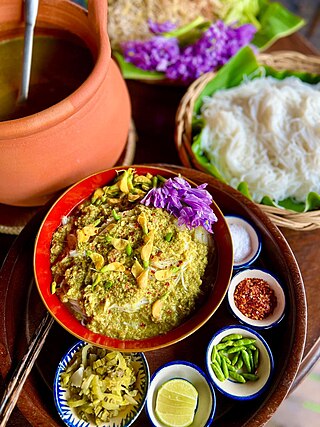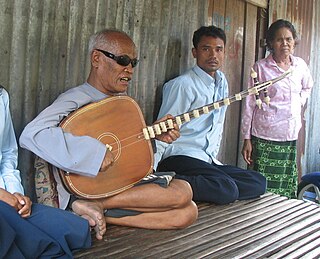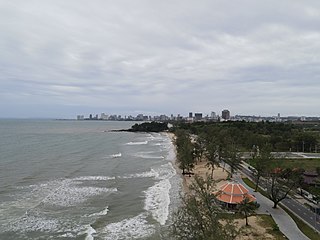
Banteay Meanchey is a province of Cambodia located in the far northwest. It borders the provinces of Oddar Meanchey to the north, Siem Reap to the east, Battambang to the south, and shares an international border with Thailand to the west. Its capital and largest city is Serei Saophoan.

Kampong Speu is a province of Cambodia. It borders the provinces of Pursat and Kampong Chhnang to the north, Kandal to the east, Takéo to the southeast, Kampot to the south and Koh Kong to the west. Its capital is the town of Chbar Mon.

Kampot is a province in southwestern Cambodia. It borders the provinces of Koh Kong and Kampong Speu to the north, Takéo to the east, Kep and the country of Vietnam to the south, and Sihanoukville to the west. To its south it has a coastline of around 45 km on the Gulf of Thailand. It is rich in low arable lands and has abundant natural resources. Its capital is the city of Kampot.

Cambodian cuisine combines the culinary traditions of many different ethnic groups in Cambodia, an important subset of which is Khmer cuisine, the nearly-two-thousand-year-old culinary tradition of the majority Khmer people. Over centuries, Cambodian cuisine has incorporated elements of Indian, Chinese, Portuguese and French cuisine, and due to some of these shared influences and mutual interaction, it has many similarities with the cuisines of Central Thailand, and Southern Vietnam and to a lesser extent also Central Vietnam, Northeastern Thailand and Laos.

Phú Quốc is the largest island in Vietnam. Phú Quốc and nearby islands, along with the distant Thổ Chu Islands, are part of Kiên Giang Province as Phú Quốc City. The island has a total area of 574 km2 (222 sq mi) and a permanent population of approximately 179,480 people. Located in the Gulf of Thailand, the island city of Phú Quốc includes the island proper and 21 smaller islets. Dương Đông ward, located on the island's west coast, is the island's administrative centre and largest town. The other ward is An Thới on the southern tip of the island.

Kampot is a city in southern Cambodia and the capital of Kampot Province. It is on the Praek Tuek Chhu River, southeast of the Elephant Mountains, and around 5 km (3 mi) from the Gulf of Thailand. Kampot was the capital of the Circonscription Résidentielle de Kampot under French rule and Cambodia's most important seaport after the loss of the Mekong Delta and before the establishment of Sihanoukville. Its center is, unlike most Cambodian provincial capitals, composed of 19th-century French colonial architecture. The region and town are known for high-quality pepper, which is exported worldwide. It is also known for its fish sauce and durian. The government and the Ministry of Culture and Fine Art have been preparing documents to nominate the Old Town of Kampot for admission to the UNESCO World Heritage Site list, since 2017.

Barsedth is a district (srok) in the south of Kampong Speu Province, in southern Cambodia. The district capital is the town of Barsedth located some 50 kilometres south of the provincial capital of Kampong Speu by road. The district shares a border with Kampot and Takeo provinces to the south. National Highway 3 forms the eastern district boundary. The district is made up of flat farmland and supports extensive agriculture and a large population.

Kong Nay, also known as Kong Nai, is a Cambodian musician from Kampot Province in southwestern Cambodia who plays a traditional long-necked fretted plucked lute called chapei dang veng. Commonly referred to as Master Kong Nay, he is a master of the chrieng chapei genre in which a solo vocalist performs semi-improvised topical material within traditional epics self-accompanied with the chapei.
In 2006, Cambodia's mineral resources remained, to a large extent, unexplored. Between 2003 and 2006, however, foreign investors from Australia, China, South Korea, Thailand, and the United States began to express their interest in Cambodia's potential for offshore oil and gas as well as such land-based metallic minerals as bauxite, copper, gold, and iron ore, and such industrial minerals as gemstones and limestone.

Preah Sihanouk, also Sihanoukville, is a province (khaet) in southwest Cambodia on the Gulf of Thailand. The provincial capital, also called Sihanoukville, is a deep water port city and a steadily growing and diversifying urban center on an elevated peninsula.

Kep is the smallest province (khaet) of Cambodia covering 336 km2 (130 sq mi), with a population of 41,798. It is one of the newest Cambodian provinces, together with Pailin, Sihanoukville and Tboung Khmum, created by Royal Decree on 22 December 2008, which separated Kep Municipality & Damnak Chang'aeur District from the Kampot province, as well as adjusting several provincial borders. It is both the smallest and least populous province of Cambodia. The provincial capital is Kep and the province contains the Kep National Park.
Koh Wai, Khmer: កោះពូលូវៃ, also known as Poulo Wai or the Wai Islands, is a group of two small wooded and uninhabited islands in the Gulf of Siam. The islands are located far away from the shore, 95 kilometres to the southwest of the coast of Preah Sihanouk Province, Cambodia. Administratively Koh Wai falls under Kampot Province. The Khmer word Koh (កោះ), means 'island' translated into English. Poulo Wai is of Malayan origin.

Kampot pepper is a cultivar of black pepper grown and produced in Cambodia. During the early 20th century under the French protectorate within French Indochina it was also known as Indochinese pepper. The pepper's modern name is derived from the area where it is grown, the Province of Kampot, but its historic name uses the French term for Mainland Southeast Asia.
Kampot Zoo (Teuk Chhou Waterfall Crop Garden and Zoo) is about 10 km from the provincial town of Kampot, Cambodia. The Zoo was established in 1999, and opened in 2000 by senator Nhim Vanda, who as of 2014 owned it and Bayap Zoo in Prey Veng Province’s Kamchay Mear District.
Hong Khaou is a Cambodian-British film director and screenwriter. He is best known for his debut feature film, Lilting, and the short films Summer and Spring.

Sihanoukville, also known as Kampong Saom, is a coastal city in Cambodia and the capital of Preah Sihanouk Province, at the tip of an elevated peninsula in the country's south-west on the Gulf of Thailand. The city has a string of beaches along its entire coastline and coastal marshlands bordering Ream National Park in the east. The city has one navigable river, the mangrove-lined Ou Trojak Jet, running from Otres Pagoda to the sea at Otres. A number of thinly inhabited islands, under Sihanoukville's administration, are near the city.
The Hun Sen Cup was the main football knockout tournament in Cambodia. The 2017 Hun Sen Cup was the 11th season of the Hun Sen Cup, the premier knockout tournament for association football clubs in Cambodia involving Cambodian League and provincial teams organized by the Football Federation of Cambodia.
Geographical Indications in Cambodia are a form of intellectual property consisting of an "which is a name or represents a geographical origin and identifies the goods as originating in such geographical area where a given quality, reputation or other characteristic of the goods is essentially attributable to its geographical origin;". Geographical indications can be registered based on the Law on Geographical Indications Registration is open for agricultural goods and foodstuffs, but also for handicraft goods
The 2022 Hun Sen Cup was the 16th season of the Hun Sen Cup, the premier knockout tournament for association football clubs in Cambodia involving Cambodian Premier League, Cambodian League 2 and provincial football clubs organized by the Football Federation of Cambodia (FFC). The competition was split into 2 stages, the provincial stage which started on 8 February 2022 and the national stage with the top four teams from provincial stage entering the play-off of national stage, competing with the teams from Cambodian League 2.

Kampot sea salt is extracted from the seawater through salt evaporation ponds in the coastal Kampot and Kep provinces. Salt farms cover around 4,748 hectares of land in both provinces and are owned by 200 families who are members of Kampot-Kep Salt Association.












